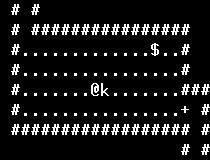Moria (1983 video game)
This article needs additional citations for verification. (January 2008) |
 Screenshot from Moria-like game | |
| Developer(s) | Robert Alan Koeneke & Jimmey Wayne Todd |
|---|---|
| Stable release | 5.5.2
/ July Template:Vgy[1] |
| Repository | |
| Operating system | Cross-platform |
| Type | Roguelike |
| License | GNU General Public License |
| Website | www-math.bgsu.edu/~grabine/moria.html |
Moria is a roguelike computer game based heavily on J. R. R. Tolkien's novel The Lord of the Rings. The game's objective is to kill a Balrog, presumably Durin's Bane, deep within the Mines of Moria. A later port of Moria called Umoria (UNIX Moria) inspired the Angband roguelike game. This game influenced the preliminary design of Blizzard Entertainment's Diablo.[2]
History
The original version was written at the University of Oklahoma by Robert Alan Koeneke and Jimmey Wayne Todd, after they became hooked on Rogue but could not run it on the VAX-11/780 minicomputer to which they had access.
Version 1.0 was written in VMS Pascal and completed in the summer of 1983. From around 1985 the source code was widely distributed under a license that permitted sharing and modification but not commercial use. Koeneke's last release was Moria 4.7 in 1986 or 1987, although more recent versions have been compiled by a variety of authors. Moria inspired a number of derivative versions. Jim E. Wilson created Umoria, a modified version in C for UNIX and MS-DOS; Umoria later became Free Software under the GNU General Public License, through the work of the free-moria project. At the University of Washington a modified Pascal version named Imoria was developed, which has been ported to C by Steve Kertes.
The current maintainer of Moria is David Grabiner.
Gameplay
Moria begins with creation of a character. The player first chooses a "race" from the following: Human, Half-Elf, Elf, Halfling, Gnome, Dwarf, Half-Orc, Half-Troll. Racial selection determines base statistics and class availability. One then selects the character's "class" from the following: Warrior, Mage, Priest, Rogue, Ranger, Paladin. Class further determines statistics, as well as the abilities acquired during gameplay. Mages, Rangers, and Rogues can learn magic; Priests and Paladins can learn prayers. Warriors possess no additional abilities.
The player begins the game with a limited number of items on a town level of six shops: a General Store, an Armory, a Weaponsmith, a Temple, an Alchemy shop, and a Magic-Users store. A staircase on this level descends into a series of randomly generated underground mazes. Deeper levels contain more powerful monsters and better treasures. Each time the player ascends or descends a staircase, a new level is created and the old one discarded; only the town persists throughout the game.
As in most roguelikes, it is impossible to re-load from a save if your character dies, as the game saves the state only upon exit, preventing save-scumming that is a key strategy in most computer games that allow saving.
The balrog (represented by the upper-case letter B) is encountered at the deepest depths of the dungeon. Once the balrog has been killed, the game has been won, and no further saving of the game is possible.
References
- ^ Aliza R. Panitz (1997-04-25). "Roguelike Games Info and FTP Sites (FAQ)". Retrieved 2011-02-04.
- ^ "[The idea for Diablo] was modified over and over until it solidified when [Dave Brevik] was in college and got hooked on … Moria/Angband." Pitts, Russ (2006-06-06). "Secret Sauce: The Rise of Blizzard". The Escapist. Retrieved 2012-12-20.
{{cite web}}: Cite has empty unknown parameter:|coauthors=(help)
External links
- Usenet article from February 21, 1996 in which Robert Alan Koeneke discusses the origins of the game.
- Steve Kertes' C port of IMoria
- The Moria Page
- kMoria, a Palm OS port of UMoria 5.5.2
- Mines of Morgoth, a Microsoft Windows remake
- Free Software Magazine - Freeing an old game discusses efforts to relicense UMoria
